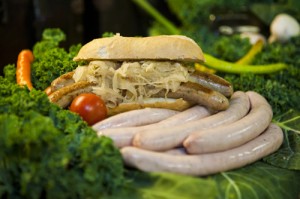During the Wurst Party we ran yesterday a few questions came up which I would like to answer.
The definition of Fresh Sausage is that it is raw meat and the most common ingredient in it is Pork, to be even more specific the Pork Shoulder Butt or Boston Butt is the cut that is very often used.
The easiest to make are Sausage Patties, which is Ground Pork, which should have at least 10% fat, mixed with the seasoning of your choice, formed into patties and fried before consumption.
No equipment needed and it is excellent with a Pork sausage seasoning, Italian, Polish or any other seasoning mix you prefer.
If you want to make Sausage links you will need a contraption to transfer your seasoned meat mixture into a casing. This is called a sausage stuffer.
Using natural casing, hog casings will give you an Italian Sausage size diameter, while sheep casings are used for breakfast sausage. If you use edible collagen casings instead, 30 mm diameter replace the hog casing and 21 mm the sheep.
As Sausage is a matter of personal taste, any recipe should be tried in a small amount and adjusted to your liking. As we cooked some samples right away at the above mentioned party, some of the guys thought that the amount of crushed red pepper in the Hot Italian was not enough, while others thought it was just right.
Seasoning: I premix the herbs and spices if there are more than 2 in the recipe, see the Bratwurst recipe on Inge’s Kitchen. That way the sausage always tastes the same and it is a lot easier to weight at the time of making the Wurst.
I always weigh up my spices in grams, it is a lot more exact and there are gram scales out there that are easily affordable.
When you make sausage at home you are not bound by the rules and regulations that commercial sausage kitchen have to adhere to. This brings me to Water.
I learned a long time ago that “dissolving” the salt and seasoning in water and pouring it over the meat makes the mixing process a lot easier. The amount of water is up to you. A little bit of advise, if you make a breakfast sausage size Wurst I would add a little more water, as it is a lot easier to force the meat through the thin tube on the stuffer to get it into the casing.
One of my friends asked me why I list the water in pounds and not in ounces. During the time we made sausage in our store, the scale was always right there, but a measuring cup was usually hard to find and if you want to make a specific amount of sausage for a custom order, adding the weight of the meat, water and seasoning together was a lot easier to calculate the final weight.
Grinding your own meat: Meat will warm up a little during the grinding process, so push it through the grinder as fast as possible. If you want to grind the meat multiple times to make a finer sausage, like a fine Bratwurst, add chipped ice or ice water to keep it cold. For the Sechsaemter Bratwurst listed on Inge’s Kitchen, I weigh some water in a bowl and set it in the freezer until it is frozen around the outside perimeter and mix it in while grinding.
So once you get started, make a smaller batch, adjust your seasoning, salt and other ingredients, be it cheese, onions, green peppers, to your liking and make sure to record the changes for future times.

